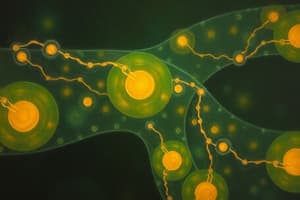Podcast
Questions and Answers
What is the primary function of contractile vacuoles in Paramecium?
What is the primary function of contractile vacuoles in Paramecium?
- Digesting food particles through enzymatic breakdown
- Regulating water balance by expelling excess fluid (correct)
- Synthesizing proteins for cellular repair
- Generating energy through cellular respiration processes
Carrier proteins facilitate transport by creating open pores through the membrane.
Carrier proteins facilitate transport by creating open pores through the membrane.
False (B)
What type of stimulus can cause gated ion channels to open or close?
What type of stimulus can cause gated ion channels to open or close?
electrical signals or chemical signals
________ are transport proteins that facilitate the rapid movement of water across cell membranes.
________ are transport proteins that facilitate the rapid movement of water across cell membranes.
Which type of transport protein undergoes a conformational change to translocate a solute across the membrane?
Which type of transport protein undergoes a conformational change to translocate a solute across the membrane?
Transport proteins are responsible for slowing down the passive movement of molecules across the membrane.
Transport proteins are responsible for slowing down the passive movement of molecules across the membrane.
What is the primary role of ion channels in cellular transport?
What is the primary role of ion channels in cellular transport?
What is the final step when the vacuole (filled with fluid) and canals contract, in paramecium?
What is the final step when the vacuole (filled with fluid) and canals contract, in paramecium?
What characteristic differentiates gated channels from other channel proteins?
What characteristic differentiates gated channels from other channel proteins?
__________ are an example of channel proteins.
__________ are an example of channel proteins.
Which type of protein spans the entire cell membrane, containing hydrophobic regions often coiled into alpha helices?
Which type of protein spans the entire cell membrane, containing hydrophobic regions often coiled into alpha helices?
Nonpolar molecules, like hydrocarbons, readily diffuse across the cell membrane without the assistance of transport proteins.
Nonpolar molecules, like hydrocarbons, readily diffuse across the cell membrane without the assistance of transport proteins.
What is the specific type of transport protein that facilitates the movement of water across cell membranes?
What is the specific type of transport protein that facilitates the movement of water across cell membranes?
The diffusion of water across a selectively permeable membrane is called ________.
The diffusion of water across a selectively permeable membrane is called ________.
Match the following terms with their correct descriptions:
Match the following terms with their correct descriptions:
In a plant cell, which state describes when the cell is in a hypotonic solution and the vacuole is full, creating pressure against the cell wall?
In a plant cell, which state describes when the cell is in a hypotonic solution and the vacuole is full, creating pressure against the cell wall?
Active transport involves the movement of substances across a membrane against their concentration gradient, requiring energy input.
Active transport involves the movement of substances across a membrane against their concentration gradient, requiring energy input.
Which of the following is a characteristic of active transport?
Which of the following is a characteristic of active transport?
The sodium-potassium pump transports both sodium and potassium ions down their concentration gradients.
The sodium-potassium pump transports both sodium and potassium ions down their concentration gradients.
A cell is placed in a solution, and water begins to move out of the cell, causing it to shrink. What type of solution is the cell in?
A cell is placed in a solution, and water begins to move out of the cell, causing it to shrink. What type of solution is the cell in?
What property of a membrane allows it to regulate the passage of substances into and out of a cell?
What property of a membrane allows it to regulate the passage of substances into and out of a cell?
What provides the energy for active transport processes?
What provides the energy for active transport processes?
_________ proteins bind to molecules and change shape to shuttle them across the membrane.
_________ proteins bind to molecules and change shape to shuttle them across the membrane.
In the sodium-potassium pump, binding of cytoplasmic Na+ stimulates ______.
In the sodium-potassium pump, binding of cytoplasmic Na+ stimulates ______.
During the operation of the sodium-potassium pump, what happens immediately after Na+ binds to the pump?
During the operation of the sodium-potassium pump, what happens immediately after Na+ binds to the pump?
In cotransport, what is the direct energy source that drives the transport of a second solute?
In cotransport, what is the direct energy source that drives the transport of a second solute?
Bulk transport, such as exocytosis and endocytosis, primarily moves small molecules and water across the cell membrane.
Bulk transport, such as exocytosis and endocytosis, primarily moves small molecules and water across the cell membrane.
Describe how plants utilize cotransport to import sugar, mentioning the specific ion gradient involved.
Describe how plants utilize cotransport to import sugar, mentioning the specific ion gradient involved.
The movement of substances into a cell by the formation of vesicles is known as ___________.
The movement of substances into a cell by the formation of vesicles is known as ___________.
Which of the following is the primary difference between active transport and cotransport?
Which of the following is the primary difference between active transport and cotransport?
Molecules always move across the cell membrane from high to low concentration, regardless of the method of transport.
Molecules always move across the cell membrane from high to low concentration, regardless of the method of transport.
Name the two types of bulk transport described.
Name the two types of bulk transport described.
Match the transport process with its description:
Match the transport process with its description:
What is the primary role of ATP in active transport?
What is the primary role of ATP in active transport?
The sodium-potassium pump is an example of an electrogenic pump.
The sodium-potassium pump is an example of an electrogenic pump.
What two forces constitute the electrochemical gradient that drives ion diffusion across a membrane?
What two forces constitute the electrochemical gradient that drives ion diffusion across a membrane?
In the sodium-potassium pump, sodium ions are expelled to the ______ of the cell.
In the sodium-potassium pump, sodium ions are expelled to the ______ of the cell.
Which of the following is NOT a function of membrane potential?
Which of the following is NOT a function of membrane potential?
Active transport moves substances down their concentration gradient.
Active transport moves substances down their concentration gradient.
What triggers the release of the phosphate group in the sodium-potassium pump cycle?
What triggers the release of the phosphate group in the sodium-potassium pump cycle?
What is the role of the proton pump in plants, fungi, and bacteria?
What is the role of the proton pump in plants, fungi, and bacteria?
What is the initial source of energy for active transport?
What is the initial source of energy for active transport?
Match the pump with the organism it belongs to:
Match the pump with the organism it belongs to:
Flashcards
Cotransport
Cotransport
Coupled transport where active transport of one solute drives the transport of another.
Plant Cotransport Example
Plant Cotransport Example
Plants use H+ gradients created by proton pumps to actively transport nutrients like sugar into cells.
Bulk Transport
Bulk Transport
Movement of large molecules via vesicles across the cell membrane. Requires energy
Exocytosis
Exocytosis
Signup and view all the flashcards
Endocytosis
Endocytosis
Signup and view all the flashcards
Movement of small molecules
Movement of small molecules
Signup and view all the flashcards
Transport Proteins
Transport Proteins
Signup and view all the flashcards
Lipid Bilayer Permeability
Lipid Bilayer Permeability
Signup and view all the flashcards
Active Transport
Active Transport
Signup and view all the flashcards
Sodium-Potassium Pump
Sodium-Potassium Pump
Signup and view all the flashcards
Extracellular Fluid
Extracellular Fluid
Signup and view all the flashcards
Cytoplasm
Cytoplasm
Signup and view all the flashcards
ATP Role in Active Transport
ATP Role in Active Transport
Signup and view all the flashcards
Phosphorylation
Phosphorylation
Signup and view all the flashcards
Electrogenic Pump
Electrogenic Pump
Signup and view all the flashcards
Membrane Potential
Membrane Potential
Signup and view all the flashcards
Electrochemical Gradient
Electrochemical Gradient
Signup and view all the flashcards
Energy
Energy
Signup and view all the flashcards
Proton Pump
Proton Pump
Signup and view all the flashcards
Voltage
Voltage
Signup and view all the flashcards
Expelled
Expelled
Signup and view all the flashcards
Proteins
Proteins
Signup and view all the flashcards
Paramecium
Paramecium
Signup and view all the flashcards
Contractile Vacuole
Contractile Vacuole
Signup and view all the flashcards
Channel Proteins
Channel Proteins
Signup and view all the flashcards
Aquaporins
Aquaporins
Signup and view all the flashcards
Gated Channels
Gated Channels
Signup and view all the flashcards
Carrier Proteins
Carrier Proteins
Signup and view all the flashcards
Facilitated Diffusion
Facilitated Diffusion
Signup and view all the flashcards
Membrane Proteins
Membrane Proteins
Signup and view all the flashcards
Conformational Change
Conformational Change
Signup and view all the flashcards
Integral Proteins
Integral Proteins
Signup and view all the flashcards
Transmembrane Proteins
Transmembrane Proteins
Signup and view all the flashcards
Selective Permeability
Selective Permeability
Signup and view all the flashcards
Passive Transport
Passive Transport
Signup and view all the flashcards
Osmosis
Osmosis
Signup and view all the flashcards
Tonicity
Tonicity
Signup and view all the flashcards
Osmoregulation
Osmoregulation
Signup and view all the flashcards
Study Notes
- The plasma membrane separates living cells from their environment and exhibits selective permeability.
Plasma Membrane Structure
- Phospholipids are a key part of the plasma membrane structure.
- Phospholipids are amphipathic, containing both hydrophilic and hydrophobic regions.
- Hydrophilic heads interact with water.
- Hydrophobic tails avoid water.
Fluid Mosaic Model
- The phospholipid bilayer has hydrophobic regions of protein within.
- The phospholipid bilayer also contains hydrophilic regions of protein.
Fluidity of Membranes
- Lipids and proteins drift laterally.
- Molecules rarely flip-flop transversely.
- Lateral movement occurs frequently (~107 times per second).
- Flip-flop movement occurs infrequently (~ once per month).
Membrane Fluidity
- Unsaturated hydrocarbon tails with kinks increase membrane fluidity.
- Saturated hydrocarbon tails decrease fluidity.
Cholesterol's Role
- At warm temperatures (37°C), cholesterol restricts phospholipid movement, reducing membrane fluidity.
- At cool temperatures, cholesterol maintains fluidity and prevents solidification by hindering tight packing of phospholipids.
Membrane Protein Types
- Peripheral proteins are bound to the surface of the membrane
- Integral proteins penetrate the hydrophobic core, called transmembrane proteins.
- Hydrophobic regions of integral proteins consist of nonpolar amino acids often coiled into alpha helices.
Functions of Membrane Proteins
- Proteins determine membrane's specific functions.
- Transport: proteins facilitate the movement of substances across the membrane.
- Enzymatic activity: proteins act as enzymes to catalyze reactions.*
- Signal transduction: proteins transmit signals from the outside to the inside of the cell.
- Cell-cell recognition: proteins enable cells to recognize each other.
- Intercellular joining: proteins mediate cell adhesion.
- Attachment to the cytoskeleton & extra cellular matrix (ECM): proteins anchor the membrane to the cytoskeleton and ECM.
Selective Permeability
- Membrane structure results in selective permeability.
- Cells exchange materials with their surroundings.
- Membranes are selectively permeable, regulating molecular traffic in and out of cells.
- Nonpolar/hydrophobic molecules (hydrocarbons, CO2, O2) can dissolve in the lipid bilayer and pass through the membrane rapidly.
- Polar/hydrophilic molecules (sugars, water) do not cross the membrane easily and require transport proteins.
Transport Proteins
- Transport proteins facilitate the passage of hydrophilic substances across the membrane.
- Channel proteins have a hydrophilic channel for certain molecules or ions to use as a tunnel.
- Carrier proteins bind to molecules and change shape to shuttle them across the membrane.
- Transport proteins are specific for the substance they move.
- Aquaporins are for the passage of water.
- A glucose transporter is specific for glucose.
Passive Transport
- Diffusion of a substance across a membrane requires no energy investment.
- Substances move from an area of high concentration to low concentration.
- Substances diffuse down their concentration gradient.
Osmosis
- Water diffuses across a membrane from an area of low solute concentration to high solute concentration.
Tonicity and Water Balance Of Cells
- Tonicity determines a cell's ability to gain or lose water.
- In an isotonic solution the solute concentration is the same as that inside the cell.
- In a hypertonic solution, the concentration is greater than that inside the cell.
- In a hypotonic solution, the concentration is less than that inside the cell.
Cell Behavior in Different Solutions
- In a hypotonic solution, an animal cell will lyse.
- In an isotonic solution, an animal cell will be normal.
- In a hypertonic solution, an animal cell will shrivel.
- In a hypotonic solution, a plant cell will be turgid (normal).
- In an isotonic solution, a plant cell will be flaccid.
- In a hypertonic solution, a plant cell will become plasmolyzed.
Osmoregulation
- Osmoregulation controls water balance.
- A contractile vacuole system controls water balance, for example in Paramecium.
- Contractile vacuoles fill with fluid from radiating canals throughout the cytoplasm.
- When full, the vacuole and canals contract, expelling fluid from the cell.
Facilitated Diffusion
- Transport proteins speed up the passive movement of molecules.
Channel Proteins
- Channel proteins provide corridors that allow specific molecules or ions to cross, such as aquaporins for water and ion channels that open or close in response to stimuli (gated channels).
Carrier Proteins
- Carrier proteins undergo a subtle change in shape that translocates the solute-binding site across the membrane.
Active Transport
- Active transport moves substances against their concentration gradient.
- It requires energy, typically in the form of ATP.
- It is performed by proteins embedded in the membranes.
- One type of active transport system is the sodium-potassium pump.
How Ion Pumps Maintain Membrane Potential
- Voltage is created by differences in the distribution of positive and negative ions.
- Membrane potential is the voltage difference across a membrane.
- The electrochemical gradient drives the diffusion of ions across a membrane.
- Chemical force (the ion's concentration gradient).
- Electrical force (the effect of the membrane potential or voltage difference) influences the ion's movement.
Electrogenic Pumps
- Electrogenic pumps are transport proteins that generates voltage across a membrane, for example:
- sodium-potassium pump (animal cells).
- proton pump (plants, fungi, bacteria).
Cotransport
- Cotransport occurs when active transport of a solute indirectly drives transport of another solute.
- Plant use the gradient of H+ ions generated by proton pumps to drive active transport of nutrients (sugar) into the cell.
Bulk Transport
- Bulk transport involves exocytosis and endocytosis processes.
- Small molecules and water enter or leave the cell across the lipid bilayer or by transport proteins.
- Large molecules (e.g., polysaccharides and proteins) cross the membrane in bulk via vesicles, requiring energy.
Exocytosis
- Transport vesicles migrate to the membrane, fuse with it, and release their contents.
- Many secretory cells, use exocytosis such as pancreatic cells exporting their products.
Endocytosis
- Cells take in macromolecules by forming vesicles at the plasma membrane.
- Three types of Endocytosis:
- Phagocytosis is cellular eating.
- Pinocytosis is cellular drinking.
- Receptor-mediated endocytosis.
Phagocytosis
- A cell engulfs a particle in a vacuole.
- The vacuole fuses with a lysosome to digest the particle.
Pinocytosis
- Molecules are taken up when extracellular fluid is "gulped" into tiny vesicles.
Receptor-Mediated Endocytosis
- Binding of ligands to receptors triggers vesicle formation.
- A ligand is a molecule that binds specifically to a receptor site of another molecule.
Studying That Suits You
Use AI to generate personalized quizzes and flashcards to suit your learning preferences.




